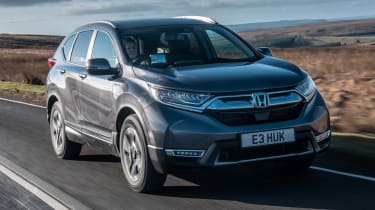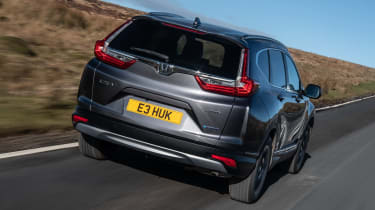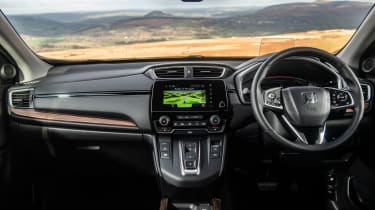New Honda CR-V EX AWD 2022 review
The CR-V is still a decent mid-sized SUV with solid build quality and a comfortable ride
Verdict
Class-leading comfort, impressive build quality and plenty of practicality consolidates the CR-V’s family-friendly credentials. However, we feel it's a car that would have benefitted from a mid-life facelift, given the ageing infotainment and frustrating powertrain. The mid-sized SUV segment moves fast and plenty of rivals now leave the CR-V in their wake.
Honda’s fifth-generation CR-V has been on sale since 2018, and while it started out in life with a 1.5 VTEC turbo petrol engine from the previous generation Civic, the CR-V is now only available as a hybrid.
Although the current CR-V looks like it’ll bow out next year to make way for a new model (we’ve seen it launch in North America already), the range still includes a number of trim options to choose from. The one we’re testing here is the range-topping EX model, which has an all-wheel drive system as standard to help it compete against its lifelong rival - the Toyota RAV4.
While the CR-V EX might not look any different to the model that landed over four years ago (the North American facelift never made it to UK shores), this range-topping model comes with plenty of impressive additional features over the entry-level S, mid-spec SE and SR variants.
More reviews
Car group tests
In-depth reviews
Road tests
Used car tests
A panoramic glass roof, head-up display, heated steering wheel, heated rear seats, wireless charging, hands free boot lid opening and an eight-way powered driver seat with memory function are all included as standard for a £4,330 premium over the £36,580 SR.
The CR-V remains the oldest model in Honda’s lineup and it shows in places when you step inside. The overall layout is fine, but it certainly lacks the wow factor many rivals (especially pure-electric ones) offer.
The seven-inch touchscreen looks a little lost in the dash - the 10.2-inch system from the latest Civic would be most welcome here as would Honda’s newer infotainment display as this is where the CR-V really feels its age. It’s not very responsive to inputs, either, and the menu design looks particularly dated now.
It’s hard to argue with the ergonomics inside the CR-V however. Every button is where you’d expect it to be and they all feel sturdy enough. The whole of the interior feels well put together, although some materials are a little cheap looking. The head-up display is operated by a button next to the driver’s leg and it brings up a somewhat disappointing glass screen rather than a projection onto the windscreen.
On the move the CR-V is pleasant enough, but don’t expect driving dynamics to match the likes of the Ford Kuga. Honda has clearly prioritised comfort for the CR-V, which really shows over rougher roads. Ruts and bumps are well managed by the soft suspension and extra sidewall of the tyres, while the seats which are extremely comfortable - adding to the overall smoothness of the CR-V.
The downside of this comfort is the CR-V’s lack of dynamism on the road. Even at low speeds there’s noticeable pitch and wallowing if you’re a little too vigorous with your inputs, and it can feel a little disconnected at times through twistier roads. Strangely, the CR-V’s steering feels very well weighted and responsive - which at times only goes to highlight the lack of chassis stability. At motorway speeds the whole car settles down into a relaxed cruise. The driving position is excellent, with a low dash line giving the driver plenty of visibility.
The brake regeneration can be adjusted by paddles behind the steering wheel. There are four options and each one has a distinct difference in terms of stopping power. There’s also the possibility of driving the CR-V in pure-electric mode, although not very far thanks to the dinky electric motor.
The engine itself feels a little underpowered at times. There’s 143bhp from a 2.0-litre turbocharged petrol unit, coupled with two electric motors to create a four-wheel drive system. The result of which is a driving experience fairly similar to an electric car, with the CVT providing seamless acceleration. Switch from Normal to Sport in the driving modes and you’ll feel a little more response from the throttle pedal but nothing more. Unfortunately, the CVT gearbox also has a typical drone - it can feel like you’re waiting for an upshift when overtaking and the lack of torque doesn’t help either. Even with all-wheel drive the 0-62mph time of 9.2 seconds can’t match the two-wheel drive model’s 8.8-second time.
The range-topping EX AWD is also worse when it comes to efficiency, with Honda claiming 39.2mpg compared to the two-wheel drive version’s 42.8mpg. CO2 emissions are higher, too, at 126g/km versus the 2WD’s 120g/km - much of this can be put down to the AWD’s 57kg extra kerb weight along with its drivetrain.
Practicality is a real strong point of the CR-V. While the 497-litre boot size isn’t class leading, the rear seats can be folded flat to make loading items easier - a process which is further made simpler by the surprisingly low boot lip. The front has plenty of storage bins and helpful features for family trips such as a minicab-esq rear-view mirror, while rear passengers benefit from heated outer seats, USB ports and plenty of head and legroom.
Now read our list of the best SUVs on sale...







